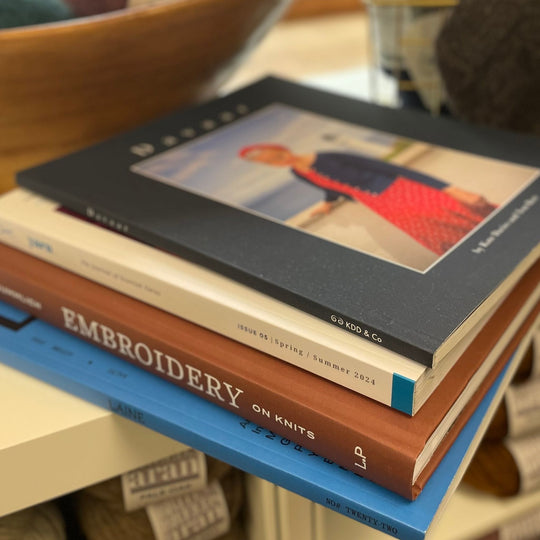Marling with Rauma by Kelsey
After a brief break to talk about other things, we’re back to Rauma, one of our favorite yarn brands here at The Woolly Thistle. I’ve talked about the four Rauma yarns we carry and have knit them up in stranded colorwork, but there’s another way to mix colors in your project that I love: marling!
In brief, marling is holding more than one yarn at a time to get a new effect in color, texture, or both, and often a new weight of yarn. If you look at the mohair blog post, you can see two examples of marling. In one example, the fingering-weight magenta Rauma Finullgarn + laceweight magenta Rauma Plum adds a fuzziness to the fabric, but didn’t change the color. But the second example knit with black Finullgarn + magenta plum added fuzziness but also added a cool mottled color effect. Holding a laceweight mohair with a fingering weight is very popular right now, with many designers adding mohair for color, texture, and/or to add a tiny bit more weight to a fabric.
Is that it for marling? Fingering weight + mohair? No way! You can marl any two yarns together and can even marl three or four strands to get a much heavier weight yarn. I knit a few swatches in Rauma to show a few examples of what you can do.

First, I knit two strands of Finullgarn together. The effect is similar to the black Finullgarn + magenta Plum in that you get the mixed color, but you don’t the mohair fuzz. It is often similar to knitting with a barberpole style yarn, where the (usually) two plies are different colors and are plied together by the mill. Garthenor makes a few of these barberpole yarns in its Snowdonia yarn line, like Idwal. But what if you could pick the two colors? Instead of just black and white, what about yellow and purple? Pink and blue? Very light and very dark green? You can do whatever you want! I knit two swatches, one on a US 7 (4.5mm) that gave me 17.5 sts per 4 inches and one on a US 9 (5.5mm) that gave me 16 stitches per 4 inches, both of which seem about right for a worsted weight. Both were in Color 459 (navy blue) and Color 400 (white).


Second, I knit a strand of Color 459 Finullgarn with a strand of Color 003 Vams. I knit a swatch with a US 10.5 (6.5mm) and got 11.5 sts per 4 inches, which is a generous bulky weight. The cool thing in the Vams swatch is that the differences in weight are very apparent. The fluffy Vams is around twice the thickness of the thinner Finullgarn, so you end up with a fabric that appears 2/3 very light grey (Vams) and 1/3 navy blue (Finullgarn).
You can estimate the weight by adding together the weight of the two strands. In Finullgarn, you get 191 yards to 50 grams, so doubled it will be the same yardage for twice the weight (two strands) = 191 yards to 100 grams. Mixed weights is a little trickier. Vams has 90 yards to 50g, so to match (approximately) the Finullgarn yardage of 191 yards, you’d need 2 balls of Vams. Then you have 180 yards of Vams in 100g plus 191 yards of Finullgarn in 50g, giving you around 180 yards for 150g, or 120 yards per 100g, which I’d call a bulky.

In short, marling is a lot of fun and it’s a great way to mix-and-match yarns to get color effects you want, new textures, or to get a new gauge. Need bulky weight but Rauma doesn’t really make one? Hold Vams and Finullgarn together in a similar color or something totally different! Like want a thinner yarn but want a custom barberpole effect? Try two strands of Gammelserie! The possibilities for customization are endless.
Kelsey Peterson is a knitter, eager student of yarn construction and sheep breeds, and employee of TWT. You can find her on Instagram as @kcrp.making and on Ravelry as yellowpaperfish.





























